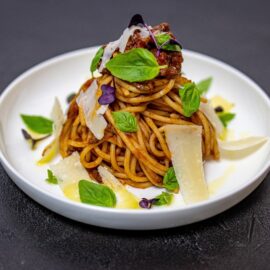DC is an exciting place to eat right now. There are so many great places to choose from. If you are looking for some new restaurants in Washington here is a list of some great ones.
Pupuseria Mama Emilia
Elsy Claros decided to break with tradition when she decided to open her own restaurant. She ventured into uncharted area with her daughter, Ericka, and their pupuseria, which bears the name of Claros’s late mother, Emilia Cruz Lopez. They use fillings that aren’t often found in more conventional Salvadoran pupuserias. Picture a traditional loroco with cheese boosted by habaneros and jalapenos. Or ham, sausage, and mortadella suspended in a special, three-cheese blend. Then imagine carrots, beets, and sweet potato packed into a sweet pupusa. It’s tough to perform this kind of experimentation with this kind of food. It requires a chef’s ability to combine such elements. It would be easy to turn a masa cake into soup in the wrong hands for example. Mama Emilia is a huge upgrade for local Salvadoran cuisine in DC.
Frank Pepe Pizzeria Napoletana
At a Bethesda mall, right next to a Cheesecake Factory, no less, how on earth was Frank Pepe Pizzeria Napoletana going to recreate the Old World elegance of its New Haven, Connecticut, location? The coal-fired oven, a duplicate of the custom-built, 100,000-pound original back on Wooster Street, holds the key. Before the pizzeria’s grand launch, the new oven was given a couple of weeks to season before producing pies that tasted authentic rather than like third-generation knockoffs. The smells of garlic and salty littleneck clams atop a white pie will make you think you’re eating them while sipping a Peroni in a booth in New Haven. Up until you turn to gaze out the window and notice the mall of course.
District Rico
Fernando and Juan Sanchez naturally gravitate toward pollo a la brasa. When the brothers’ grandmother first started a store in Lima, three generations of their family have been selling exquisite, charcoal-grilled birds. Their Peruvian chicken, which is dry-brined, heavily spiced with cumin, and cooked over natural wood charcoal, is unmatched. Yet, this third generation of restaurateurs is likewise extending the definition of a pollo a la brasa shop. The majority of the chicken used in their subs, salads, and Mission-style burritos is freshly taken from the rotisserie. The meat elevates those dishes to a level that Chipotle and Sweetgreen could never reach. It is so charred and smokey that you’ll never look back.
Ramona’s Pizza Garden
Unfortunately the likelihood is high that you won’t have the opportunity to try this place just yet. Or at least not until Ramona’s sign a lease for a legitimate sit-down establishment. At some point, due to its popularity, they ceased adding people to their waiting list. The crowd peaked at 700 people, all of whom were clamoring for a sample of the excellent pan pizzas. They resemble Detroit pies but are prepared in their own distinctive way.
Lapu Lapu
During the pandemic, so many establishments stopped serving breakfast. It was a a victim of a labor shortage and the higher wages requested by those who did agree to work in restaurants despite the high risk and low reward. Moreover, a lot of people were working from home, where we could easily prepare our own coffee. Javier and Jennifer Fernandez opened Lapu Lapu; a corner store that specializes on breakfast sandwiches with American and Philippine influences, in June.
The proprietors are the same couple who run the renowned Kuya Ja’s Lechon Belly in Rockville. Cebuchon, a roast pork belly prepared in the Philippines that is frequently compared to porchetta, is their specialty. Lechon leftovers are used to make Lapu Lapu’s best invention, the paksiw sandwich. This is made from a muddle of braised pork simmered in a variety of sauces including soy sauce, brown sugar, garlic, and cane vinegar. It is then served on a pandesal bread with a fried egg. If it weren’t for the other treats on the menu, you could solely eat this every day.
Z&Z Manoushe Bakery
Danny Dubbaneh claims that the flatbread existed a long time before pizza. He is referring to the well-known Levantine manoushe. Three brothers co-founded this restaurant in Rockville. They are rightly very proud of their heritage and culinary history. The brothers believe that pizzas shouldn’t have to dominate the American dining scene. They argue that manoushe shouldn’t be viewed in the context of pizza by using historical examples. Instead they suggest that it would be more reasonable to view pizza within the context of Middle Eastern flatbreads. They are correct. Also, they offer an outstanding selection of manakish. Start with the famous za’atar manoushe, which is covered in the homemade spice mixture.
La Tingeria
The name of David Andres Pea’s food truck, La Tingeria, was a reference to its signature dish when it first debuted in 2013. Nowadays the dish is frequently eclipsed by other dishes meals that have captured the public’s attention. These include the goat and beef birria tacos that Pea added to the truck during the epidemic, either with or without cheese. At the restaurant Pea launched in Falls Church last year, the quesobirria tacos are a real hit.
Even if it benefited from our national obsession with all things birra during the pandemic, their status is well-deserved. With his stewed meats, cheese, and packed within a tortilla coated in birria oil, Pea meticulously layers flavors. Indeed, these tacos are awesome. Don’t let the birria hype blindside you so you miss out on Pea’s tinga though: a hunk of braised chicken breast whose strong heat is matched by sweet caramelized onions.
Spice Kitchen
Olumide Shokunbi had a plan for Spice Kitchen from the very beginning. The owner and chef sought to open a Nigerian restaurant that appealed to everyone. Shokunbi, a former general manager at a Chipotle in his hometown of Bowie, Maryland, had embraced the restaurant chain’s ethos and believed that His Spice Kitchen would, like the Mexican-inspired giant, have wide appeal. The goal was achieved. The popular grilled and flavored skewers known as suya are introduced to everyone here.
The process has been exquisitely streamlined. There are just a few skewers available, some of which are traditional (beef, chicken). While others aren’t they are all coated with a spice mixture that Shokunbi buys from Nigeria and enhances with his own ideas. The skewers are earthy and spicy at the same time. They are served on top of food-grade wax paper intended to resemble the newspaper provided with suya in the mother country. It’s just one of many wonderful touches in this place.



